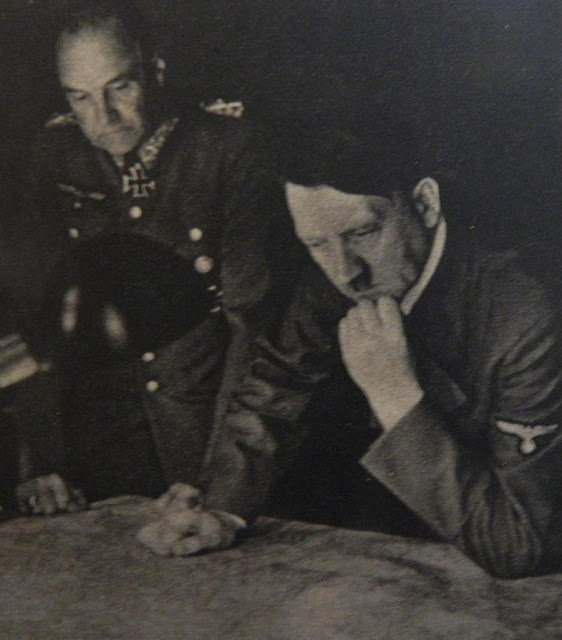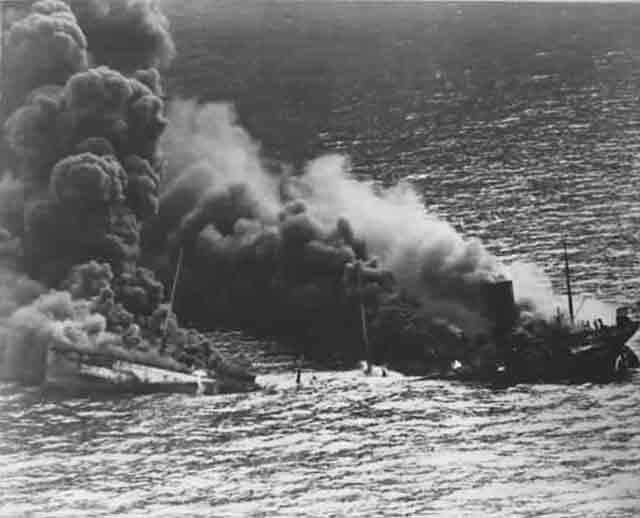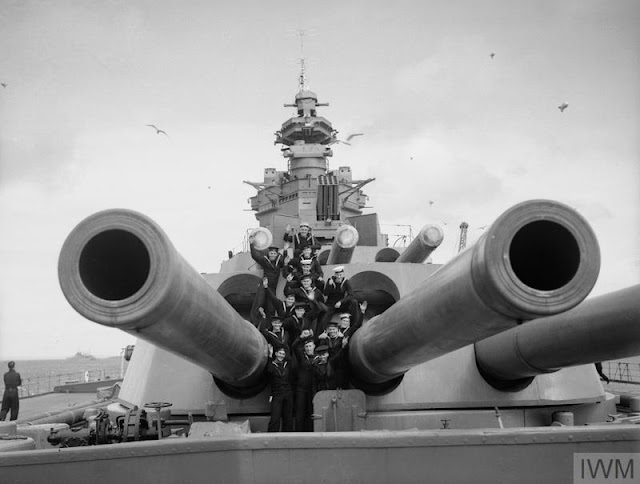Monday 23 June 1941
 |
| Soviet troops head to the front, 23 June 1941 (© SPUTNIK/ ANATOLIY GARANIN). |
Eastern Front: Slovakia declares war on the USSR on
23 June 1941, joining Germany and Italy. Hungary and Finland remain on the sidelines, though both are gearing up for war. Croatia offers to send troops to assist the Wehrmacht.
Operation Barbarossa continues, with action on all the major axes of advance.
In Army Group North (Field Marshal Wilhelm Ritter von Leeb), the German 4th Panzer Group faces an ineffective counterattack by Soviet 3rd and 12th Mechanized Corps in the Battle of Raseiniai. The Germans are barely slowed, but the Soviets continue attacking because they don't have another plan. By the end of the day, the German tanks have advanced about 50 miles.
 |
| A Soviet KV-1 heavy tank. |
The Battle of Raseiniai is significant not because of its tactical effect, but because the Germans experience a severe shock at Soviet tank strength. Specifically, at one point a single Soviet KV-1 or KV-2 tank pierce the German lines and winds up at a column of German trucks of the 6th Panzer Division. When four 50-mm anti-tank guns prove ineffective in stopping it, the Germans move up a heavy 88-mm Flak gun to about 730 meters (800 yards), but the Soviet tank destroys it before it can fire (Flak guns have no protection and are very immobile). This standoff lasts until the 25th when another 88-mm gun and some German panzers finally destroy it. This proves beyond a shadow of a doubt that German military intelligence was sorely lacking about Soviet tank strength.
In Army Group Center, 2nd Panzer Group and 3rd Panzer Group break out past the Bug River. General Guderian's 2nd Panzer Group shrugs off Soviet 4th Army, bypasses Brest Fortress, and takes the main road toward Minsk. General Hermann Hoth's 3rd Panzer Group sidesteps Soviet 3rd Army and heads toward Vilnius, which its forward units reach late in the day.
In Army Group South, the terrain is advantageous to the defense, and this axis of advance gives the Wehrmacht the most problems. German 1st Panzer Group and 6th Army have broken through Soviet 5th Army, but late on the 23rd, the Soviets make their first serious counterattack in the Battle of Brody (considered the largest tank battle of the war up until the Battle of Kursk in July 1943). Soviet 22nd and 15th Mechanized Corps, containing new T-34 medium and KV heavy tanks, hit the flanks of the advancing 1st Panzer Group from north and south, respectively. This develops into a lengthy battle, but eventually, the German III Motorized Corps destroys the 22nd Mechanized Corps, while the 6th Army's 297th Infantry Division handles the Soviet 15th Motorized Corps.
Soviet bombers attack Constanta. Lieutenant Horia Agarici, flying a Hurricane from Mamaia Airfield, shoots down three bombers and disperses the formation. According to Romanian practice which counts twin-engined aircraft as a "double kill," this makes Agarici an "ace in a day" with six confirmed kills. Lt. Agarici quickly becomes a celebrity due to the happenstance that his brother-in-law composes a rhyming ditty which roughly goes, "Agarici is fighting the Bolshevici."
Luftwaffe fighter ace Max-Hellmuth Ostermann claims two Soviet bombers downed
Syrian/Lebanon Campaign: Habforce from Iraq attacks Palmyra, the site of a major Vichy French airbase. The French continue holding Palmyra largely because of their dominance of the skies in the sector.
Australian troops of the 2/33 Battalion attempt to outflank the Vichy French in Merdjayoun by capturing Ibeles Saki. However, the Vichy French there continue to hold out.
During the night of the 22/23, French destroyer Guepard sorties briefly from Beirut Harbor and runs into Royal Navy light cruisers HMS Leander and Naiad, along with three Royal Navy destroyers. After a brief exchange of gunfire, both Guepard and Leander are lightly damaged and Guepard retires to Beirut.
The British establish a 5000-man 1st Greek Brigade in Palestine under the command of Colonel Ev. Antoniou. This formation, however, requires training and cannot be used right away.
 |
| New York Times, 23 June 1941. |
European Air Operations: RAF Bomber Command raids Cologne with 62 aircraft and Dusseldorf with 41 bombers. After dark, it raids Kiel with 26 bombers.
RAF Bomber Command sends 39 aircraft on anti-shipping missions and other planes on Circus missions to Chocqueres and Mardyck. Luftwaffe ace "Pips" Priller of I,/JG 26 shoots down a Spitfire. Both sides take losses, with the Luftwaffe losing 8-victory ace Carl-Hans Röders when he is killed during the melee and the RAF losing two bombers.
The RAF completes its first chain of GEE guidance stations, with three now set up. These will be used to guide RAF bombers to their targets.
Battle of the Baltic: The Soviets scuttle a number of submarines at the Latvian port of Libau to avoid capture: M-71, M-80, Ronis, and Spidola. In the confused actions today, some of these might be sunk by German forces, but that is unclear.
U-144 (Friedrich von Hippel) torpedoes and sinks 206-ton Soviet submarine M.78 east of Ventspils and west of Windau, Latvia. All 15 men on board perish. This is the only victory in the career of U-144.
German motor torpedo boat S-60 engages in a surface gun battle with Soviet submarine S-3 off Libau. After the Soviet submarine submerges, S-60 sinks it with depth charges. Everybody on S-3 perishes.
German motor torpedo boats S-35 and S-60 torpedo and sink Soviet submarine S.3 off Steinort, Poland.
German motor torpedo boat sinks Soviet lightship Khiumadal in the Baltic.
German motor torpedo boat S-44 torpedoes and sinks Soviet freighter Alf off Tallin, Estonia.
Soviet cruiser Maksim Gorki hits a mine in the Baltic. This causes extensive damage, blowing off its bow all the way to the first turret. The cruiser makes it to Leningrad for repairs.
Soviet destroyer Gnevny its a mine north of Hiiumaa, Estonia. It apparently makes it back to port, but there are conflicting accounts that say it sinks today.
 |
| Map of the opening stages of Operation Barbarossa. |
Battle of the Atlantic: U-203 (Kptlt. Rolf Mützelburg) begins shadowing Convoy HX-133 and calls for assistance from other U-boats. Eventually, ten U-boats engage the convoy. This begins a major convoy battle that develops over several days.
The crew of German supply ship Alstertor scuttles it after being intercepted by Royal Navy destroyers Faulknor, Foresight, Forester, Foxhound, and Fury of the 8th Destroyer Flotilla. Included among the survivors picked up by the destroyers are 78 British prisoners of war taken from British freighters Rabaul and Trafalgar.
The Luftwaffe bombs and sinks 5265-ton British freighter Trelissick near Sheringham Buoy, Cromer. There are two deaths.
The Luftwaffe bombs and damages 1351-ton British freighter Tolworth a few miles off Cromer. The Tolworth makes it to the Tyne for repairs.
The Luftwaffe bombs and damages Royal Navy transport HMT Nogi off Cromer. Two other transport ships, Contender and Solon, take Nogi in tow, but it eventually sinks.
British 717-ton freighter Hull Trader hits a mine and sinks near No. 57C Buoy off Cromer. There are 11 deaths.
British 324-ton freighter Camroux II hits a mine and is damaged off Flamborough Head. The Camroux II makes it to Immingham in tow.
Royal Navy destroyers HMS Eggesford, Melbreak and Tantaside are laid down.
U-519 is laid down.
 |
| "Forgive Me, Comrade." Cartoon published on 23 June 1941 in the London Daily Mail depicting Hitler's betrayal of his 1939 pact with Stalin (Copyright ©Houghton Mifflin Company. All rights reserved). |
Battle of the Mediterranean: During the early morning hours, the Luftwaffe raids Alexandria Harbor for just under two hours. They manage a near-miss of battleship HMS Warspite. This floods two bulges, and the ship needs repairs.
The Luftwaffe and Regia Aeronautica bomb Tobruk.
The RAF based on Malta attacks Syracuse Harbor. The British damage a hangar, some barracks, and some flying boats.
Battle of the Black Sea: The Luftwaffe bombs and sinks Soviet destroyer Bystry in the port of Sevastopol. The Soviets later salvage the Bystry.
Soviet destroyer Dnepr hits a mine and sinks in Sevastopol Harbor.
Soviet military tug SP-12 hits a mine and sinks in Sevastopol Harbor.
 |
| A junior German officer over a fallen comrade on the second day of the invasion of Russia, June 23, 1941. |
Propaganda: The German News Service announces:
Early Sunday morning 9 Russian Glenn Martin bombers flew into East Prussia and 7 of them were shot down by German fighter planes. In another attempted raid on military installations in the General Government of Poland close behind the front lines, all but 2 out of 35 Russian bombers were destroyed by German fighter planes.
The Soviet Stavka issues Communique No. 1:
Early in the morning of June 22, the troops of the German-Fascist Wehrmacht attacked our border forces along the entire line extending from the Baltic Sea to the Black Sea. The enemy Luftwaffe bombed a number of our airfields and villages, but everywhere it encountered energetic resistance from our fighter planes and ground defenses, which inflicted heavy losses on the Hitlerite Fascists. Sixty-five German aircraft were shot down.
These dueling versions of reality serve to reinforce the preferred narratives of each combatant. The Germans are pushing the narrative that it has been attacked and is responding, while the Soviets are anxious to show that national morale is terrific and its troops are competently warding off the invaders. Neither narrative is accurate, with both attempting to create false impressions in order to stiffen troop and civilian resolve.
 |
| Field Marshal Walther von Brauchitsch and Hitler over the map at Fuhrer headquarters, Rastenburg, East Prussia, June/July 1941. How Hitler allowed himself to be photographed at the map table varies throughout the war - at this stage, he prefers to be seen dominating the map while his military figure stands off submissively to the side. |
German/Soviet Relations: German Foreign Minister Joachim Ribbentrop sends a cable to Tokyo requesting that they declare war on the Soviet Union via Manchuria (Manchukuo). The Japanese take this into consideration, but ultimately decide to wait until the Germans take Moscow, Stalingrad, and other key objectives in the western USSR. The Japanese military forms a committee to look into the desirability of either attacking north (into the USSR) or south (against the British and Dutch).
At some point during this week - details are very sketchy - Soviet Premier Joseph
Stalin attempts to broker a peace deal with Hitler through a Bulgarian diplomat, Ivan Stamenov. Foreign Minister Molotov has Lavrentiy Beria arrange this by using one of Beria's subordinates, NKVD officer Pavel Sudoplatov, who has a "casual" lunch at a Moscow restaurant with the diplomat. Sudoplatov explains to Stamenov what to say to Hitler. Stalin is willing to offer huge concessions for peace, including giving the Reich all of Ukraine and all of the areas granted to him in the "secret protocol" to the 23 August 1939 Molotov/Ribbentrop Pact in the Baltic States. Stalin does, though demand to know why Hitler invaded the USSR.
Hitler turns Stalin down flat and will not even consider the offer. This is one of Hitler's biggest mistakes. These revelations were hidden for many years but came to light during the period after Stalin died from natural causes in the 1950s. There are few other details of this little-known incident, but there is no reason to doubt that it happened. This peace offer was classified as treason and was one of the charges used to condemn Beria to death. The others involved - including the Bulgarian Stamenov diplomat used as the go-between - submitted affidavits confirming the incident. Sudoplatov confessed to it under interrogation and also was convicted of treason, serving 15 full years in prison (yes, there are many questions about the validity of such "proof," but there was a lot of corroboration). Molotov was never tried for treason despite his deep role in the incident, but gradually fell out of favor, lost his positions one by one, and by 1962 was a "non-person" in the Soviet bureaucracy.
German/Italian Relations: Mussolini offers to send a corps (three divisions) of Italian troops to the eastern front. The Germans are glad for the help but expect more.
Soviet/Finnish Relations: The Soviets evacuate their embassy in Helsinki.
 |
| Soviet KV-2 tank at the Battle of Raseiniai. |
Soviet Military: The Soviet Main Military Council, now reduced from eleven to seven members, is renamed the "Stavka" (General Headquarters) of the High Command. The change is made by eliminating six deputy defense commissars and adding General Voroshilov and Admiral Kuznetsov. Other members include Generals Timoshenko, Semen Budenny and Zhukov, Foreign Minister Molotov, and of course Stalin. There are numerous "advisors" to the Stavka: Beria, Shaposhnikov, Meretskov, Vatutin, Kulik, Zhigarev, Voronov, Mikoyan, Kaganovich, Voznesensky, Zhdanov, Malenkov, and Mekhlis. However, only the seven are permanent members.
While there are seven members of the Stavka, it is understood by everyone that Stalin has the last word on everything. This is long-established Soviet (and Russian) practice, with someone (such as Stalin) holding the
de facto power while someone else holds the
de jure power. Timoshenko technically is the chairman of the Stavka, but Stalin has the real power. As Zhukov says at one point, the difference between Stalin and the highest-ranking Soviet Marshal is the same as between a Marshal and a private. This lineup will remain intact and function effectively through crises, with some of the members there due to ability (such as Zhukov) and others there simply because they are Stalin's cronies (such as Budenny).
Already, recriminations are raining down from Stalin on military figures that he feels are failing in their defense of the country. Soviet Bomber Commander General Kopets commits suicide, the first of many. By some accounts, Stalin is in the midst of a personal crisis brought on by Operation Barbarossa.
Full conscription is introduced throughout the Soviet Union.
 |
| Junkers Ju 87B Stukas being escorted by Bf 109s during the early stages of Operation Barbarossa, June 1941. |
US Military: Admiral Stark, US Navy Chief of Operations, orders the 1st Defense Battalion of the Fleet Marine Force to Wake Island.
German Government: Adolf Hitler, aboard his command train Amerika, reaches his forward headquarters at Rastenburg, the Wolf's Lair (Wolfschanze) at about 01:30. This is his first visit to the Wolf's Lair, which is still under construction (and will be throughout the war).
Lithuania: Lithuanian partisans led by Juozas Ambrzevicius (Juozas Brazaitis) liberate Vilnius and Kaunas. Leonas Prapuolenis of the Lithuanian Activist Front broadcasts an announcement of Lithuanian independence over the radio, introducing the Provisional Government of Lithuania and its leaders. This begins a trend during World War II in which a prime military objective is to seize radio stations quickly in order to make declarations such as this. Ambrzevicius serves as the Provisional Government's first (acting) prime minister.
While most Soviets flee quickly, some decide to stay. These include some Soviet security personnel. When the rebels find them on 23 June, they lock the Soviets (who allegedly include some Jews) in a garage. Eventually, in a very controversial incident, the Soviets are killed - exactly by whom is the controversy. Some say the Soviets are killed by the Germans, others recently that recently liberated political prisoners kill them.
 |
| The Kaunas pogrom at the Lietukus Garage, June 1941. This shows the captives being sprayed with hoses prior to execution. |
Latvia: German 18th Army crosses the border into Latvia.
Croatia: Serbs in eastern Herzegovina rebel against the controlling Italian authorities in the Independent State of Croatia. About 200 Ustaše state police encounter a group of rebels they estimate to number between 600 and 1,000 and take severe casualties. This apparently spontaneous uprising lasts well into July. This is sometimes termed the first operation by Tito's partisans, but it is unlikely that he is involved at this stage.
Soviet Homefront: The secret police (NKVD) arrest and imprison about 3000-4000 Ukrainians in Lviv as a security measure, kill some indiscriminately. The Soviet government rightly suspects the loyalties of Ukrainians - because of Soviet actions like this.
British Homefront: Railway workers get the Southern Railway Central Station in London back into operation after damage from a Luftwaffe raid on the night of 21/22 June.
American Homefront: Life Magazine publishes pictures of the sinking of Egyptian passenger liner Zamzam by commerce raider Atlantis on 17 April taken by photographer David E. Sherman in its 23 June 1941 issue. This article has a big influence on US public opinion about the war.
 |
| Soviet Premier Joseph Stalin. |
June 1941 June 1, 1941: Farhud PogromJune 2, 1941: Massacres on CreteJune 3, 1941: Kandanos MassacreJune 4, 1941: Kaiser Wilhelm Passes AwayJune 5, 1941: Death in ChungkingJune 6, 1941: Hitler's Commissar OrderJune 7, 1941: Commandos Strike at PessacJune 8, 1941: British Invade Syria and LebanonJune 9, 1941: Litani River BattleJune 10, 1941: British Take AssabJune 11, 1941: Hitler Thinking Beyond RussiaJune 12, 1941: St. James AgreementJune 13, 1941: Lützow DamagedJune 14, 1941: Latvian June DeportationsJune 15, 1941: Operation BattleaxeJune 16, 1941: The Old LionJune 17, 1941: British Spanked in North AfricaJune 18, 1941: Turkey Turns Its BackJune 19, 1941: Cheerios IntroducedJune 20, 1941: Birth of US Army Air ForceJune 21, 1941: Damascus FallsJune 22, 1941: Germany Invades RussiaJune 23, 1941: A Soviet KV Tank Causes HavocJune 24, 1941: Kaunas and Vilnius FallJune 25, 1941: Finland Declares WarJune 26, 1941: Bombing of KassaJune 27, 1941: Encirclement At MinskJune 28, 1941: Minsk FallsJune 29, 1941: Brest Fortress FallsJune 30, 1941: Mölders Becomes Top Ace2020
































